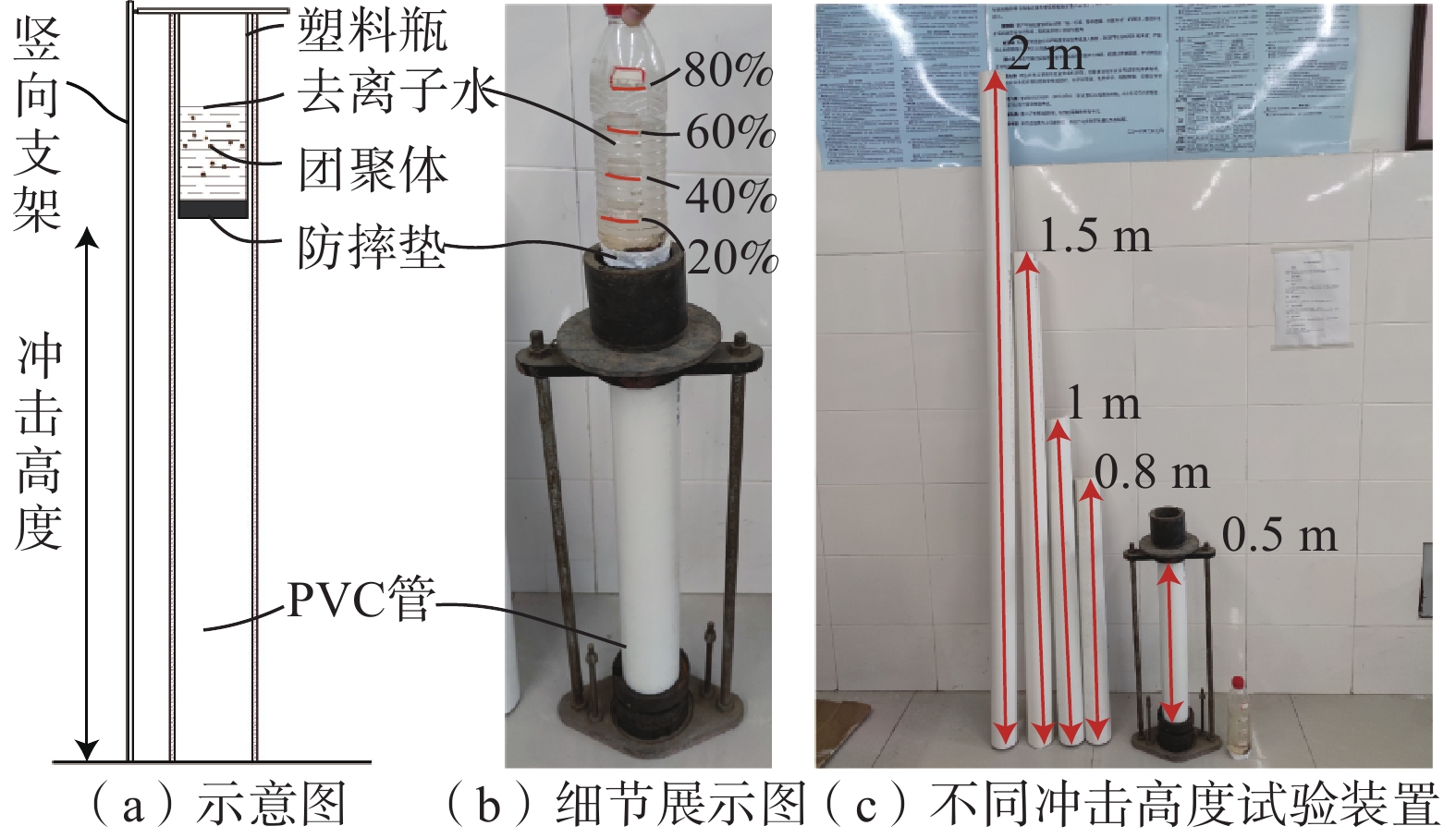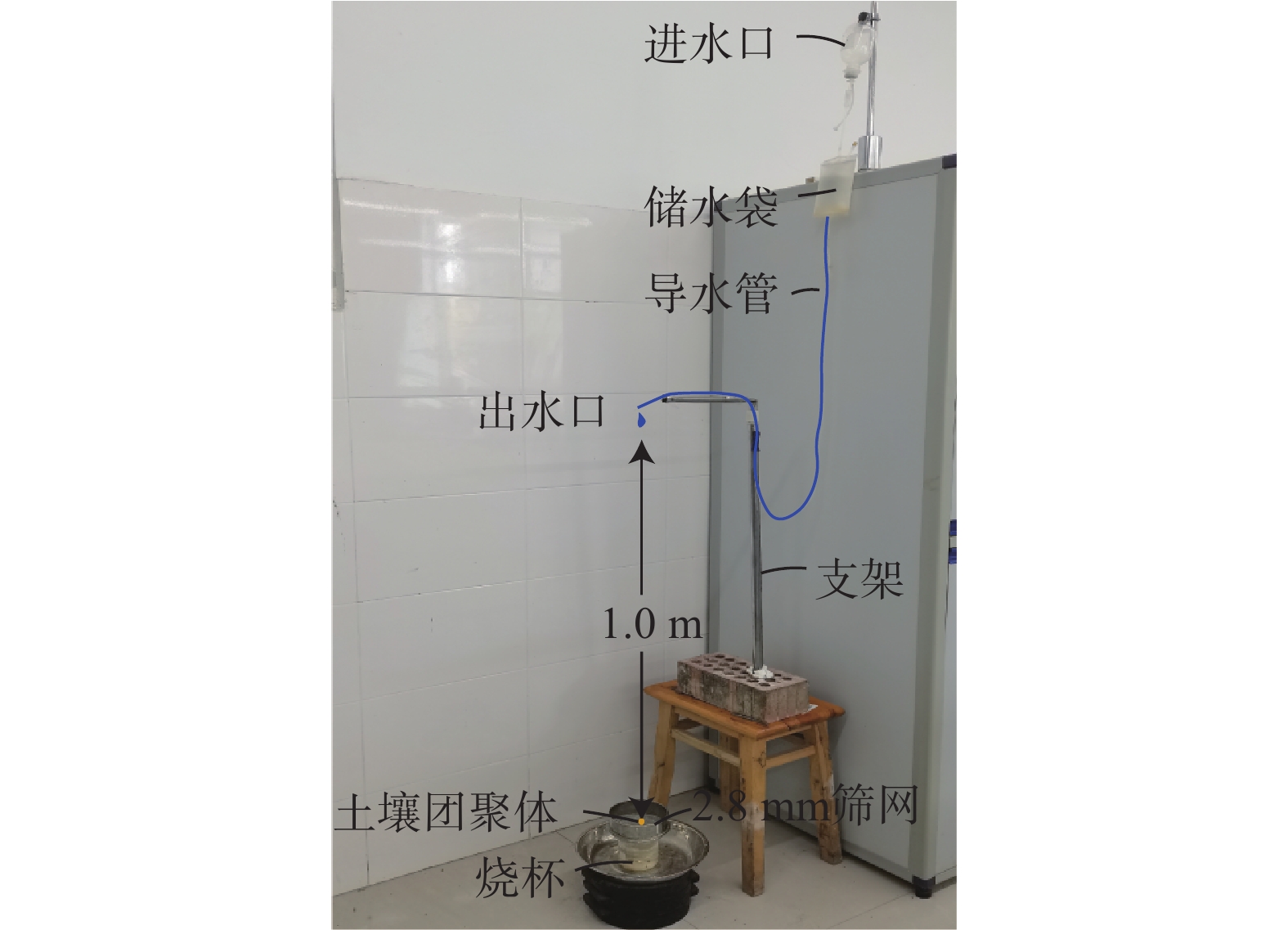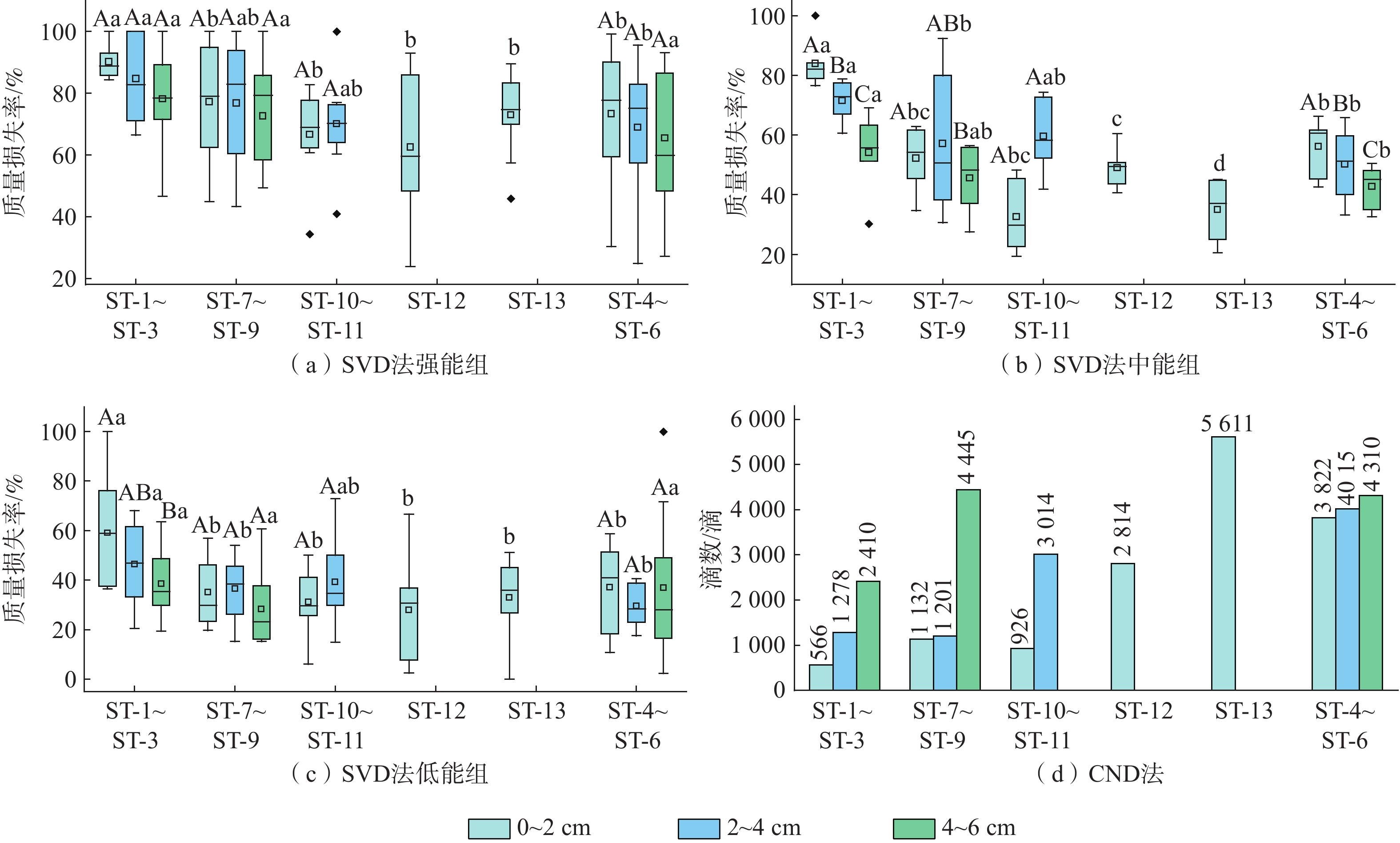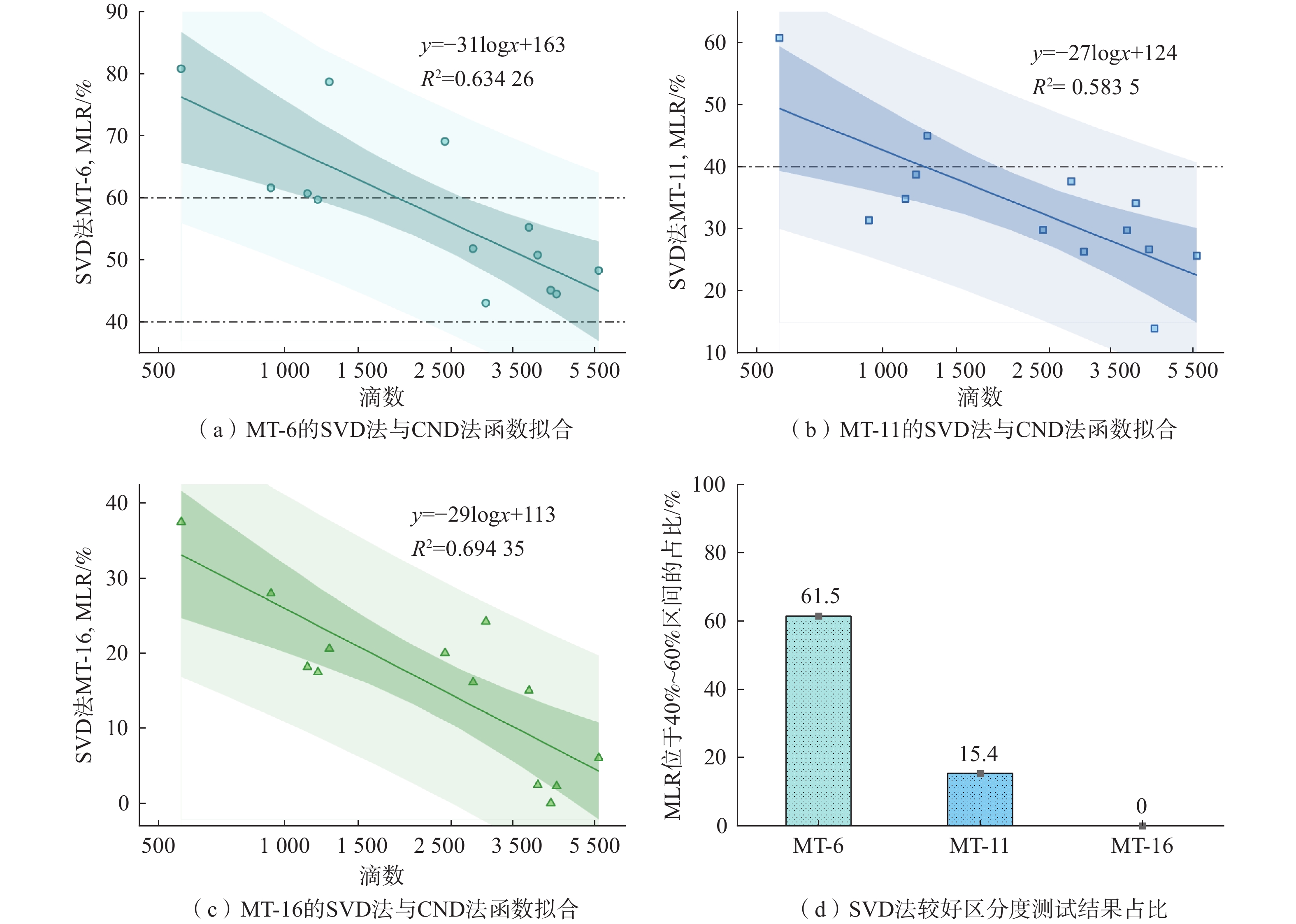An in-situ method for assessing soil aggregate stability in burned landscapes
-
摘要: 森林火灾后因火烧迹地土壤斥水性,导致坡面径流和土壤可蚀性增强,提高了火后泥石流易发性,而土壤团聚体稳定性是影响土壤入渗能力和侵蚀敏感性的关键指标。目前常用于火烧迹地土壤团聚体稳定性测定的水滴冲击测定方法(counting the number of water drop impacts,CND),不适用于原位测定且耗时较长(滴定一组团聚体需要数小时)。因此文章提出一种基于冲击振荡破坏效应的团聚体稳定性测定方法(shock and vibration damage method,SVD)。充分考虑容重、有机质含量和斥水性对土壤团聚体稳定性的影响,通过室内火烧模拟试验,制备了13种类型的土壤团聚体。采用自制的试验仪器进行SVD法正交试验测定土壤团聚体质量损失率,并与传统CND法测得的破坏团聚体的水滴数量进行对比。结果表明:SVD法的测定MT-6方案(冲击高度1 m、容器容水量40%、冲击5次、测定团聚体20颗)与CND法的测定结果具有很强的一致性(Kendall系数=0.797)和相关性(R2=0.634),测定时间较短(测定一组团聚体约5 min),且测定结果区分度较好(约62%的团聚体MLR位于区分度良好的40%~60%区间),将其作为SVD法的最优测定方案。此外,SVD法试验装置结构简单、便携易拆卸,可用于原位快速且定量地区分火烧迹地不同火烈度下土壤团聚体稳定性水平,对火烧迹地土壤侵蚀、水土流失治理以及火后泥石流起动机理研究具有重要指导意义。Abstract: Due to soil repellency in burned areas, slope runoff and soil erodibility escalates following forest fires, increasing the vulnerability to post-fire debris flows. Soil aggregate stability is a critical determinant of soil infiltration capacity and erosion susceptibility. The prevalent method of assessing soil aggregate stability in burned areas, the counting the number of water drop impacts (CND) method, is time-intensive and impractical for in-situ measurements. In response, this study introduces a novel technique based on the shock and vibration damage (SVD) effect for evaluating soil aggregate stability in burned areas. Thirteen distinct soil aggregate types were meticulously prepared for indoor simulated fire testing, with due consideration to factors such as bulk weight, organic matter content, and water repellency, which influence stability of soil aggregates. Employing a custom-built test apparatus, the mass loss rate (MLR) of soil aggregates was determined through orthogonal experiments using the SVD method and compared against the standard CND technique's quantification of water droplet-induced aggregate destruction. The findings demonstrated that SVD method, employing Test Scheme 6 (testing 20 aggregates, 1-meter impact height, 40% water content, and five impacts), exhibits excellent agreement (Kendall coefficient = 0.797) and correlation (R2 = 0.634) with CND method outcomes. This testing scheme, characterized by rapid determination and effective discrimination, is identified as the optimal testing approach. The SVD testing apparatus is straightforward, portable, and easily disassembled, rendering it suitable for on-site use. It can be used to distinguish the stability level of soil aggregates swiftly and quantitatively under various fire intensities in burned areas in situ, which is an important guiding significance for the study of soil erosion, erosion control, and post-fire debris flow initiation mechanism in burned areas.
-
•特别致谢•
2020年,54位审稿专家付出很多时间和精力为本刊审读稿件,为提高期刊学术质量做出了重要贡献。编辑部全体成员对所有参与审稿的专家表示最衷心的感谢!
表 1 2020年度《中国地质灾害与防治学报》审稿专家(按姓氏笔画为序) 姓名 单位 姓名 单位 马凤山 中国科学院地质与地球物理研究所 张永双 中国地质科学院水文地质环境地质研究所 王 清 吉林大学 张永波 太原理工大学 王文沛 中国地质环境监测院 张志龙 中国矿业大学(北京) 王贤能 深圳市工勘岩土集团有限公司 张鸣之 中国地质环境监测院 王树仁 河南理工大学 陈红旗 中国地质环境监测院 王桂杰 中国地质环境监测院 陈昌彦 北京市勘察设计研究院有限公司 王雁林 陕西省国土资源厅地质环境处 陈洪凯 枣庄学院 牛瑞卿 中国地质大学(武汉) 佴 磊 吉林大学 齐 干 中国地质环境监测院 赵文祎 中国地质环境监测院 邢爱国 上海交通大学 赵鲁强 中国气象局公共气象服务中心 朱赛楠 中国地质环境监测院 胡凯衡 中国科学院水利部成都山地灾害与环境研究所 乔建平 中国科学院水利部成都山地灾害与环境研究所 胡卸文 西南交通大学 向喜琼 贵州大学 胡新丽 中国地质大学(武汉) 刘东升 重庆市地质矿产勘查开发局 姜月华 中国地质调查局南京地质调查中心 刘希林 中山大学 夏元友 武汉理工大学 闫金凯 中国地质科学院 钱江澎 四川省地质工程勘察院 江 耀 中国科学院水利部成都山地灾害与环境研究所 徐则民 昆明理工大学 许国辉 中国海洋大学 唐辉明 中国地质大学(武汉) 孙文洁 中国矿业大学(北京) 黄波林 三峡大学 孙亚军 中国矿业大学 曹修定 中国地质调查局水文地质环境地质调查中心 孙红福 中国矿业大学(北京) 龚士良 中国地质调查局地面沉降研究中心 李 忠 防灾科技学院 韩 冰 中国地质环境监测院 李树志 中煤科工集团唐山研究院有限公司 喻孟良 中国地质环境监测院 肖锐华 中国地质环境监测院 程国明 中国地质环境监测院 何发亮 中铁西南科学研究院有限公司 温铭生 中华人民共和国应急管理部 余志山 甘肃省地质环境监测院 谭维贤 内蒙古工业大学 邹正盛 河南理工大学 魏云杰 中国地质环境监测院 第八届《中国地质灾害与防治学报》优秀论文评选结果
为了鼓励广大作者撰写高质量的科技论文, 推动我国地质灾害防治工程行业的学术交流, 提升和扩大《中国地质灾害与防治学报》的办刊质量与影响力, 《中国地质灾害与防治学报》编辑部从2013年起开展优秀论文评选活动。
评选活动遵守客观公正, 严格筛选, 优中选优的原则。 由责任编辑提出推荐名单, 并参考一年中论文的被引频次、下载次数和影响程度, 经编辑部认真初评和复评, 按得票高低评选出优秀论文。
2019年《中国地质灾害与防治学报》发表论文112篇, 从中评选出第八届《中国地质灾害与防治学报》优秀论文20篇。希望获奖作者再接再厉, 开拓创新, 为推动我国地质灾害防治工程学科的发展继续努力!
表 2 第八届《中国地质灾害与防治学报》优秀论文名单(2019年发表)题目 作者 期刊 中国西藏金沙江白格滑坡灾害研究 王立朝,温铭生,冯振,孙炜锋,魏云杰,
李俊峰,王文沛第一期 库水位波动及降雨作用下巫峡干井子滑坡流-固耦合特征及稳定性分析 梁鑫,殷坤龙,陈丽霞,康璇,杨永刚,张亮 第一期 汉江孤山航电枢纽工程区近坝滑坡稳定性分析及防治工程建议 王启国 第一期 基于不同因子分级法的滑坡易发性评价——以湖北远安县为例 闫举生,谭建民 第一期 基于函数赋值模型与模糊综合评判法的单沟泥石流危险性评价 尚慧,王明轩,罗东海,冯皎,王爱军,薛跃明 第一期 地质灾害无人机调查数据管理云平台建设 马娟,张鸣之,韩冰,黄喆,石爱军 第一期 高分二号卫星数据在地质灾害调查中的应用——以重庆万州区为例 董文,潘建平,阳振宇,夏鑫,张定凯,
向淇文,曹建虎,廖振环第一期 邻近输电塔路堑边坡失稳风险定量评估及加固工程设计优化 林阿娜,王浩,颜斌,戴旭明,胡燮,赵小盘,王晨 第二期 单体危岩崩塌灾害危险性评价——以贵州威宁县新发乡樊家岩为例 武中鹏,刘宏,董秀群,邓凯伦 第二期 降雨和库水联合作用下边坡稳定性变化规律 徐翔,王义兴,方正 第二期 秦望山隧道南口高陡岩质边坡稳定性分析及治理效果评价 郝社锋,蒋波,喻永祥,宋京雷,徐昊,孙少锐 第二期 黄土湿陷系数影响因素的相关性分析 朱凤基,南静静,魏颖琪,白兰 第二期 地质灾害防治标准化建设的思考 刘传正 第三期 重庆甑子岩崩塌落石动力学特征及危险性分区 孙敬辉,石豫川 第三期 基于离散元的含软弱夹层岩质边坡滑移机理分析 范昊天,孙少锐,王亚山,张纪星,刘宝生 第三期 广西桂林市规划中心城区岩溶发育特征及分布规律 江思义,吴福,刘庆超,李海良,吴莹莹 第三期 降雨引发的兰州黄土滑坡时空规律分析和临界降雨量预测 朱晓霞,张力,杨树文 第四期 湖北武汉典型地区岩溶发育特征分析 李慧娟,金小刚,涂婧,魏瑞均,李海涛,杨涛 第四期 广西桂林市规划中心城区岩溶塌陷易发性评价 吴福,江思义,刘庆超,何源,李海良 第五期 湖北武汉岩溶塌陷时空分布规律及其影响因素分析 涂婧,魏瑞均,杨戈欣,刘长宪,金小刚,李海涛 第六期 -
图 3 SVD法与CND法测试结果
注:①(a)为强能组,对应方案MT-4、9、10、15、18、19、20、22、24;(b)为中能组,对应方案MT-1、6、12、13、21、23;(c)为低能组,对应方案MT-2、3、5、7、8、11、14、16、17、25。②高温亲水:ST-1~ST-3,轻度斥水:ST-7~ST-9,强烈斥水:ST-10~ST-11,严重斥水:ST-12,极端斥水:ST-13。③同一土壤层不同小写字母代表显著性差异(P < 0.05);同一斥水性不同大写字母代表显著性差异(P < 0.05),相同字母表示差异不显著,误差条表示测量结果平均值的标准误差。
Figure 3. Test results of the SVD method and CND method
表 1 供试土壤主要物理化学性质
Table 1 Key physical and chemical properties of the studied soils
指标 高温亲水组 天然对照组 轻度斥水组 强烈−极端斥水组 ST-1 ST-2 ST-3 ST-4 ST-5 ST-6 ST-7 ST-8 ST-9 ST-10 ST-11 ST-12 ST-13 温度/(°C) 600 600 600 常温 常温 常温 200 200 400 200 400 200 400 时间/min 120 120 120 \ \ \ 5 60 5 30 5 60 5 深度/cm 0~2 2~4 4~6 0~2 2~4 4~6 0~2 2~4 4~6 0~2 2~4 0~2 0~2 斥水性 亲水 亲水 亲水 强烈
斥水轻度
斥水亲水 轻度
斥水轻度
斥水轻度
斥水强烈
斥水强烈
斥水严重
斥水极端
斥水干容重/(g·cm−3) 0.95 1.04 1.16 0.95 1.04 1.16 0.95 1.04 1.16 0.95 1.04 0.95 0.95 初始有机质含量/% 14.0 9.48 6.93 14.0 9.48 6.93 14.0 9.48 6.93 14.0 9.48 14.0 14.0 注:亲水(WDPT≤5 s),轻度斥水(WDPT:5~60 s),强烈斥水(WDPT:60~600 s),严重斥水(WDPT:600~3600 s),极端斥水(WDPT:>3600 s)[23],ST-1~13代表团聚体类型编号。 表 2 团聚体稳定性测定正交试验设计表
Table 2 Table for orthogonal test design for determining aggregation stability
测定方法编号 A/% B/cm C/次 D/颗 测定方法编号 A/% B/cm C/次 D/颗 MT-01 40 80 10 10 MT-14 80 100 1 10 MT-02 100 50 3 10 MT-15 20 100 10 25 MT-03 80 50 5 15 MT-16 20 50 1 5 MT-04 20 80 15 15 MT-17 60 80 5 5 MT-05 60 50 10 20 MT-18 100 200 5 25 MT-06 40 100 5 20 MT-19 20 150 5 10 MT-07 80 80 3 25 MT-20 60 200 15 10 MT-08 100 80 1 20 MT-21 40 200 1 15 MT-09 100 150 10 15 MT-22 80 200 10 5 MT-10 80 150 15 20 MT-23 100 100 15 5 MT-11 60 150 1 25 MT-24 20 200 3 20 MT-12 40 150 3 5 MT-25 60 100 3 15 MT-13 40 50 15 25 注:影响因素A是容器容水量,B是冲击高度,C是冲击次数,D单次测试所需土壤团聚体颗数,MT-1~25代表SVD法试验方案。 表 3 SVD法各方案与CND法的一致性检验结果
Table 3 Consistency test results between various schemes of the SVD method and the CND method
方案 Kendall系数 P 方案 Kendall系数 P 方案 Kendall系数 P 方案 Kendall系数 P MT-1 0.827 0.071 MT-8 0.687 0.170 MT-15 0.791 0.089 MT-22 0.726 0.134 MT-2 0.299 0.845 MT-9 0.709 0.149 MT-16 0.918 0.037 MT-23 0.684 0.173 MT-3 0.495 0.456 MT-10 0.723 0.137 MT-17 0.581 0.304 MT-24 0.679 0.178 MT-4 0.654 0.206 MT-11 0.890 0.045 MT-18 0.874 0.051 MT-25 0.604 0.270 MT-5 0.761 0.108 MT-12 0.874 0.051 MT-19 0.659 0.199 MT-6、
MT-11、
MT-160.797 0.000 MT-6 0.904 0.041 MT-13 0.780 0.095 MT-20 0.815 0.076 MT-7 0.728 0.133 MT-14 0.659 0.199 MT-21 0.794 0.087 注:表中P为显著性,P值小于0.05,说明具有显著一致性;Kendall系数值代表一致性程度(较差:<0.2,一般:0.2~0.4,中等:0.4~0.6,较强:0.6~0.8,很强:0.8~1.0)[25]。 -
[1] 胡卸文,金涛,殷万清,等. 西昌市经久乡森林火灾火烧区特点及火后泥石流易发性评价[J]. 工程地质学报,2020,28(4):762 − 771. [HU Xiewen,JIN Tao,YIN Wanqing,et al. The characteristics of forest fire burned area and susceptibility assessment of post-fire debris flow in jingjiu township,xichang City[J]. Journal of Engineering Geology,2020,28(4):762 − 771. (in Chinese with English abstract) DOI: 10.13544/j.cnki.jeg.2020-224 HU Xiewen, JIN Tao, YIN Wanqing, et al . The characteristics of forest fire burned area and susceptibility assessment of post-fire debris flow in jingjiu township, xichang City[J]. Journal of Engineering Geology,2020 ,28 (4 ):762 −771 . (in Chinese with English abstract) DOI: 10.13544/j.cnki.jeg.2020-224[2] BADÍA-VILLAS D,GONZÁLEZ-PÉREZ J A,AZNAR J M,et al. Changes in water repellency,aggregation and organic matter of a mollic horizon burned in laboratory:Soil depth affected by fire[J]. Geoderma,2014,213:400 − 407. DOI: 10.1016/j.geoderma.2013.08.038
[3] VARELA M E,BENITO E,KEIZER J J. Effects of wildfire and laboratory heating on soil aggregate stability of pine forests in Galicia:The role of lithology,soil organic matter content and water repellency[J]. CATENA,2010,83(2/3):127 − 134.
[4] ZAVALA L M,GRANGED A J P,JORDÁN A,et al. Effect of burning temperature on water repellency and aggregate stability in forest soils under laboratory conditions[J]. Geoderma,2010,158(3/4):366 − 374.
[5] JORDÁN A,ZAVALA L M,MATAIX-SOLERA J,et al. Effect of fire severity on water repellency and aggregate stability on Mexican volcanic soils[J]. CATENA,2011,84(3):136 − 147. DOI: 10.1016/j.catena.2010.10.007
[6] WIETING C,EBEL B A,SINGHA K. Quantifying the effects of wildfire on changes in soil properties by surface burning of soils from the Boulder Creek Critical Zone Observatory[J]. Journal of Hydrology:Regional Studies,2017,13:43 − 57.
[7] JIMÉNEZ-PINILLA P,MATAIX-SOLERA J,ARCENEGUI V,et al. Advances in the knowledge of how heating can affect aggregate stability in Mediterranean soils:a XDR and SEM-EDX approach[J]. CATENA,2016,147:315 − 324. DOI: 10.1016/j.catena.2016.07.036
[8] 胡卸文,王严,杨瀛. 火后泥石流成灾特点及研究现状[J]. 工程地质学报,2018,26(6):1562 − 1573. [HU Xiewen,WANG Yan,YANG Ying. Research actuality and evolution mechanism of post-fire debris flow[J]. Journal of Engineering Geology,2018,26(6):1562 − 1573. (in Chinese with English abstract) DOI: 10.13544/j.cnki.jeg.2018-073 HU Xiewen, WANG Yan, YANG Ying . Research actuality and evolution mechanism of post-fire debris flow[J]. Journal of Engineering Geology,2018 ,26 (6 ):1562 −1573 . (in Chinese with English abstract) DOI: 10.13544/j.cnki.jeg.2018-073[9] 郭军玲,王虹艳,卢升高. 亚热带土壤团聚体测定方法的比较研究[J]. 土壤通报,2010,41(3):542 − 546. [GUO Junling,WANG Hongyan,LU Shenggao. Comparative studies on measurement methods for aggregate stability of subtropical soils[J]. Chinese Journal of Soil Science,2010,41(3):542 − 546. (in Chinese with English abstract) DOI: 10.19336/j.cnki.trtb.2010.03.007 GUO Junling, WANG Hongyan, LU Shenggao . Comparative studies on measurement methods for aggregate stability of subtropical soils[J]. Chinese Journal of Soil Science,2010 ,41 (3 ):542 −546 . (in Chinese with English abstract) DOI: 10.19336/j.cnki.trtb.2010.03.007[10] SCHOMAKERS, J., et al . Measurement of soil aggregate stability using low intesity ultrasonic vibration[J]. Spanish Journal of Soil Science,2011 ,1 (1 ):8 −19 .SCHOMAKERS, J., et al. Measurement of soil aggregate stability using low intesity ultrasonic vibration[J]. Spanish Journal of Soil Science,2011,1(1):8 − 19.
[11] AKSAKAL E L,ANGIN I,SARI S. A new approach for calculating aggregate stability:mean weight aggregate stability (MWAS)[J]. CATENA,2020,194:104708. DOI: 10.1016/j.catena.2020.104708
[12] AMÉZKETA E. Soil aggregate stability:a review[J]. Journal of Sustainable Agriculture,1999,14(2/3):83 − 151.
[13] 黄悦等,基于高能水分特性法的土壤团聚体结构稳定性研究进展[J]. 水土保持研究,2022 :1 − 8. [HUANG Yue,et al. Progress in Research on Structural Stability of Soil Aggregates Based on High Energy Moisture Characteristic Method[J]. Research of Soil and Water Conservation,2022 :1 − 8. (in Chinese with English abstract) HUANG Yue, et al. Progress in Research on Structural Stability of Soil Aggregates Based on High Energy Moisture Characteristic Method[J]. Research of Soil and Water Conservation, 2022 : 1 − 8. (in Chinese with English abstract)
[14] THOMAZ E L. Effects of fire on the aggregate stability of clayey soils:A meta-analysis[J]. Earth-Science Reviews,2021,221:103802. DOI: 10.1016/j.earscirev.2021.103802
[15] 成小彬. 水锤振荡器的关键技术研究与结构设计[D]. 北京:中国石油大学(北京),2017. [CHENG Xiaobin. Research on key technology of water hammer oscillator and its structural design[D]. Beijing:china university of petroleum (bei jing),2017. (in Chinese with English abstract) CHENG Xiaobin. Research on key technology of water hammer oscillator and its structural design[D]. Beijing: china university of petroleum (bei jing), 2017. (in Chinese with English abstract)
[16] IMESON A C,VIS M. Assessing soil aggregate stability by water-drop impact and ultrasonic dispersion[J]. Geoderma,1984,34(3/4):185 − 200.
[17] MCCALLA T M. Water-drop method of determining stability of soil structure[J]. Soil Science,1944,58(2):117 − 122. DOI: 10.1097/00010694-194408000-00002
[18] ALMAJMAIE A,HARDIE M,ACUNA T,et al. Evaluation of methods for determining soil aggregate stability[J]. Soil and Tillage Research,2017,167:39 − 45. DOI: 10.1016/j.still.2016.11.003
[19] RAWLINS B G,TURNER G,WRAGG J,et al. An improved method for measurement of soil aggregate stability using laser granulometry applied at regional scale[J]. European Journal of Soil Science,2015,66(3):604 − 614. DOI: 10.1111/ejss.12250
[20] 张绍科,胡卸文,王严,等. 四川省冕宁县华岩子沟火后泥石流成灾机理[J]. 中国地质灾害与防治学报,2021,32(5):79 − 85. [ZHANG Shaoke,HU Xiewen,WANG Yan,et al. Disaster mechanism of post-fire debris flow in Huayanzi gully,Mianning County,Sichuan Province[J]. The Chinese Journal of Geological Hazard and Control,2021,32(5):79 − 85. (in Chinese with English abstract) DOI: 10.16031/j.cnki.issn.1003-8035.2021.05-09 ZHANG Shaoke, HU Xiewen, WANG Yan, et al . Disaster mechanism of post-fire debris flow in Huayanzi gully, Mianning County, Sichuan Province[J]. The Chinese Journal of Geological Hazard and Control,2021 ,32 (5 ):79 −85 . (in Chinese with English abstract) DOI: 10.16031/j.cnki.issn.1003-8035.2021.05-09[21] 胡彩莉,马玉贞,郭超,等. 烧失量法测定土壤有机质含量的实验条件探究[J]. 地球与环境,2016,44(1):110 − 118. [HU Caili,MA Yuzhen,GUO Chao,et al. Optimization of the experiment conditions for estimating organic matter content with loss-on-ignition method[J]. Earth and Environment,2016,44(1):110 − 118. (in Chinese with English abstract) DOI: 10.14050/j.cnki.1672-9250.2016.01.015 HU Caili, MA Yuzhen, GUO Chao, et al . Optimization of the experiment conditions for estimating organic matter content with loss-on-ignition method[J]. Earth and Environment,2016 ,44 (1 ):110 −118 . (in Chinese with English abstract) DOI: 10.14050/j.cnki.1672-9250.2016.01.015[22] 孔凡伟. 如何精测土壤容重[J]. 黑龙江农业科学,2010,(10):178. [KONG Fanwei. How to accurately measure soil bulk density[J]. Heilongjiang Agricultural Sciences,2010,(10):178. (in Chinese) KONG Fanwei . How to accurately measure soil bulk density[J]. Heilongjiang Agricultural Sciences,2010 , (10 ):178 . (in Chinese)[23] BISDOM E B A,DEKKER L W,TH SCHOUTE J F. Water repellency of sieve fractions from sandy soils and relationships with organic material and soil structure[J]. Geoderma,1993,56(1/2/3/4):105 − 118.
[24] 程佳会,范成伟,徐晓兵,等. 正交试验下黏土导热系数影响分析[J]. 江西建材,2022(3):34 − 36. [CHENG Jiahui,FAN Chengwei,XU Xiaobing,et al. Influence analysis of thermal conductivity of clay under orthogonal test[J]. Jiangxi Building Materials,2022(3):34 − 36. (in Chinese with English abstract) CHENG Jiahui, FAN Chengwei, XU Xiaobing, et al . Influence analysis of thermal conductivity of clay under orthogonal test[J]. Jiangxi Building Materials,2022 (3 ):34 −36 . (in Chinese with English abstract)[25] 侯勋,方刚. 基于肯德尔系数的改进ID3算法[J]. 科学技术创新,2021,(22):21 − 22. [HOU Xun,FANG Gang. Improved ID3 algorithm based on Kendall coefficient[J]. Scientific and Technological Innovation,2021,(22):21 − 22. (in Chinese) HOU Xun, FANG Gang . Improved ID3 algorithm based on Kendall coefficient[J]. Scientific and Technological Innovation,2021 , (22 ):21 −22 . (in Chinese)[26] LI Qiwen,AHN S,KIM T,et al. Post-fire impacts of vegetation burning on soil properties and water repellency in a pine forest,South Korea a[J]. Forests,2021,12(6):708,2021
[27] 李萌. 热声制冷机板叠内工质流动与换热规律研究[D]. 包头:内蒙古科技大学,2021. [LI Meng. Study on the flow and heat transfer laws of working medium in the stack of thermoacoustic refrigerator[D]. Baotou:Inner Mongolia University of Science & Technology,2021. (in Chinese with English abstract) LI Meng. Study on the flow and heat transfer laws of working medium in the stack of thermoacoustic refrigerator[D]. Baotou: Inner Mongolia University of Science & Technology, 2021. (in Chinese with English abstract)




 下载:
下载:





 邮件订阅
邮件订阅 RSS
RSS